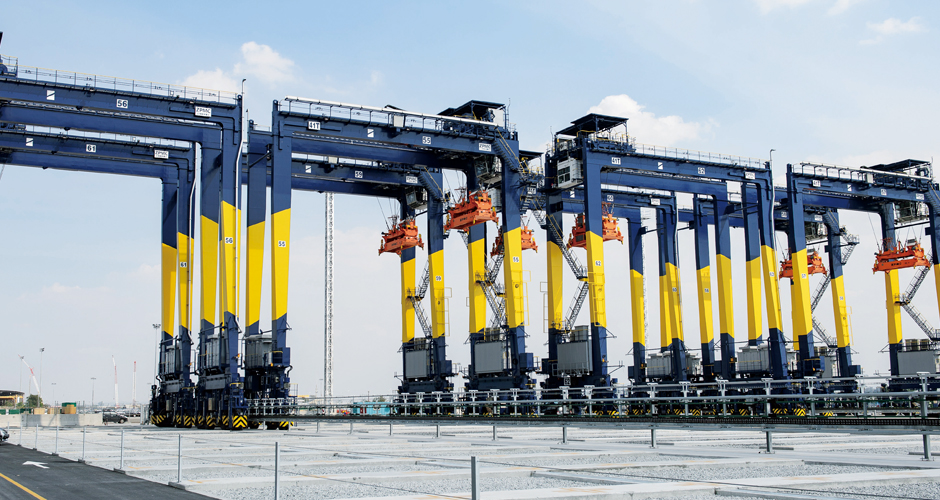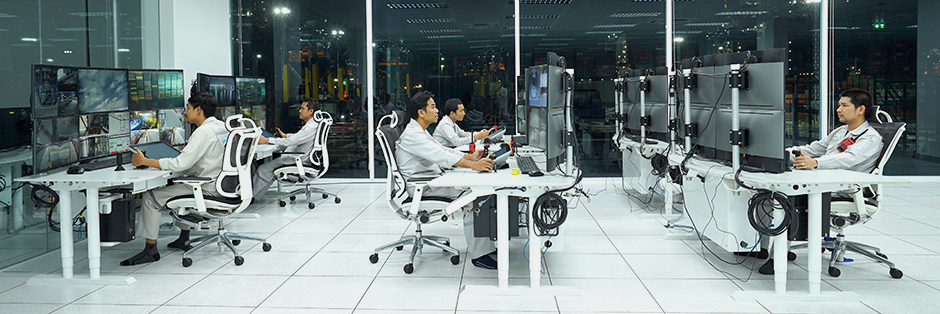 22nd December 2022
22nd December 2022
For many years the gantry crane, the unsung hero of container terminal operations, has dominated the skylines to ports around the world. However, its origins are in the ancient world of Greece and Rome, whose engineers used the lifting equipment to build cities, roads and temples across their empires thousands of years ago.
The Ancient Greek’s used the word ‘crane’ for the lifting equipment as its construction resembled that of the wading bird. The appearance of the lifting device, with its vertical column and a boom that usually points up at an angle and can rotate, looks similar to the long neck and beak of a standing bird, the crane. The earliest known cranes were developed by the Ancient Greeks in the 6th Century B.C.
The Greek Empire was a series of small independent states and unlike other civilisations did not have access to slave labour to work on infrastructure and building projects, so they developed the crane.
The Romans for their part adopted the Greek cranes and improved construction to lift heavier loads, they equipped cranes with large treadwheel drives, for example, according to The History of Cranes published by Cargo-Partners.
The Romans went on to construct cranes that could lift more than 100 tons lifting a stone block 19 metres to build the Temple of Jupiter in Baalbek in Lebanon. Today we can marvel at Trajan’s Column in Rome, where a gantry crane lifted 53 tons of stone with a height of 34 metres.
To the modern day, the first pure hydraulic gantry was designed and built in 1963 by Hartley Belding, then the Chief Engineer of Belding Engineering Company in West Chicago, Illinois, in the United States. The company was awarded a project contract to dis-assemble and relocate a sink factory. Belding decided to design a gantry style crane raised up so that it could lift the large and heavy presses used in the manufacture of metal kitchen sinks.
The main advantage of the gantry for Belding was that because of the height of the crane it was possible for the presses to be lifted in a horizontal position to be loaded directly onto waiting trucks with flatbed trailers. This concept become a major design benefit that led to the use of gantry cranes to lift containers horizontally on ship-to-shore operations.
At the same time as Belding’s invention of the modern gantry cranes in the 1960s, Malcolm McLean’s containerisation revolution was also underway in the United States, with Sea-Land the first shipping line to launch scheduled services using containers with service to Vietnam.
In late 1968, a commercial container ship service was inaugurated from the Far East to the United States.
This service was expanded to markets in Hong Kong and Taiwan in 1969, and to Singapore, Thailand, and the Philippines in 1971.
The one main challenge McLean faced in his drive to standardise the shipping industry through containerisation was that many of the US and international ports did not have gantry cranes to maximise the efficiency of loading and unloading the boxes.
McLean soon became a board member of Sea-Land and the company was a pioneer in the construction of container ships and the first container terminals in New Jersey and Hong Kong. McLean’s standardisation vision went on to become the bedrock for container shipping worldwide.
In the container terminal operating ecosystem, the gantry crane is not only the most expensive and important piece of cargo-handling machinery but potentially also a major bottleneck restricting the working efficiency of the entire terminal. All major container terminals have invested heavily in the quay crane’s reliability and efficiency such is the importance of the equipment to the overall terminal.
Yard cranes, terminal tractors and quay cranes are used to transport containers between wharf and yard and vice-versa. Quay cranes’ container handling speed is the performance indicator for container terminals and measured in Moves Per Hour (MPH). As such, quay cranes with high reliability and availability are paramount to ensure the desired container handling performance is achieved.
Container handling equipment at ports have been developed to handle increasingly heavy loads, with higher speeds and built-in safety technology. With the current disruption in the supply chain and frequent delays to shipping schedules the need to quickly load and unload cargo at each port has become essential.
Quay cranes have once again become the focal point of the drive to greater productivity, helping shave time off each box move. The advancements in science and technology have enabled quay cranes weighing over 2,000 metric tonnes to be designed, built and operated. The quay cranes are constructed to the required specifications of each container terminal to ensure durability, availability, and reliability under the varying operating conditions.
The first major leap forward for gantry cranes since containerisation is the move from manual to remote control and full automation.
As ports around the world move towards full automation one important interim step has already been taken on a broader scale, that is to introduce remote operations on all types of cranes, eliminating interruptions caused by breaks and moving staff between cranes, enabling the use of higher crane motion speeds and acceleration.

Remote control operations provide an ergonomic working environment for the equipment operators and enables unified management of exception handling for cranes, gate and vehicle identification contributing to maximised net production time.

The world’s largest automated container port Yangshan Port in Shanghai was built with an investment of US$2.15bn. In total the terminal can handle a maximum of 6.3 million twenty-foot equivalent units (TEUs) of cargo.
Plans are to automate 120 rail-mounted gantry cranes at Yangshan Port as well as 130 automated guided vehicles (AGVs) and 26 bridge cranes.
Devices previously operated manually will be replaced by smart ones. These smart facilities will automatically perform production tasks as instructed by the system. Yard staff will remotely control bridge cranes, rail-mounted gantry cranes, and AGVs.
The terminal’s operating system has been exclusively developed by Shanghai International Port Group’s (SIPG) research and development team and is designed to enable port machinery to perform loading and unloading operations simultaneously. The operating system is spread across 2.23 million square metres of the port’s area.
One of the major advances in container terminal operations has been the advent of Global Positioning System (GPS) technology, enabling pinpoint accuracy of yard equipment and boxes providing a digital map of all the moving parts in a port.
The effectiveness of a quay crane relies heavily on its integration into the terminal operation system, and synchronising with other terminal equipment are all essential to maximising the overall efficiency of the terminal.

The development of Artificial Intelligence (AI) has enabled container terminals around the world to leverage greater efficiency across a range of yard equipment including gantry cranes. AI allows for the optimisation of processes and the synchronisation to deploy and position equipment most effectively and efficiently. On a high level, it works by analysing a dataset and looking for patterns that it can draw conclusions. It essentially learns to ‘fill in the blanks.’ AI’s value to gantry crane operations is that it constantly checks for anomalies that human operators might not even know about.
AI is now frequently deployed at container terminals as the operations are often repetitive and confined to a specific area within the terminal. It allows data from specific operations and equipment to be gathered, enabling AI to enhance and improve operational performance.
The popularity of Automated Robot Cranes (ARC) is growing in recent years, particularly in the freight and logistics industry; and now being installed at shipping ports and container terminals. ARC are cranes that are integrated with Artificial Intelligence (AI) technology and can perform tasks autonomously or be controlled remotely by operators working indoors in a control centre.
These cranes have technology which can detect objects close to the equipment capabilities with sensors and HD cameras including workers or objects, when detected the equipment stops instantly and helps to avoid collisions, accidents, and delays during operations to ensure terminal safety.
By merging AI technology with crane machinery, repetitive tasks results in cost savings for the operator through a reduction in time taken to perform tasks, less damage to equipment and cargo, fewer workforce injuries and improved utilisation of assets.
With large gantry cranes the maintenance costs are very high and the lost revenue caused by breakdowns can be expensive for the terminal operator.
Planned maintenance ensures that regular upgrading and replacement of mechanical and technical parts and components.
In order to minimise the inefficient operations of gantry cranes and maximise efficient operations, the use of Digital Twin* technology is a valuable tool to terminal operators to optimise performances at different levels and can develop a maintenance schedule that minimises gantry crane inefficiencies or breakdowns.
*A digital twin is a virtual representation of an object or system that spans its life cycle, is updated from real-time data, and uses simulation, machine learning and reasoning to help decision-making. (Source: IBM)
As momentum builds to reduce emissions in shipping, the spotlight is also turning on to port equipment and the use of green, renewable sources of energy.
The use of hydrogen fuel cell technology is one of the energy sources being trialled at ports across the world. Currently the focus is on heavy-duty trucks and cargo-handling equipment. Hybrid power systems for gantry cranes are being developed using a combination of low carbon fuels and hydrogen energy batteries for a range of port machinery. This interim solution moves the port industry a step closer to realising net-zero emissions of CO2 and contributes to building a greener port environment.
The hybrid energy solution can reduce carbon dioxide emissions of a traditional quay crane by 300 tons a year when compared to high-powered diesel generators, based on an annual average of 120,000 TEU movements. The equipment provides electricity for the whole machine by hydrogenation, and only discharges purified water during the whole process. (Source: Seatrade Maritime News)
The quay crane has come a long way since the 6th century B.C. and moved from a project-based engineering tool to becoming the single most important piece of equipment at the modern port.
The simple construction of the gantry crane has not changed in all those thousands of years, but has been constantly improved, refined and through the advent of advanced technology remains essential to the productivity of container shipping and world trade.